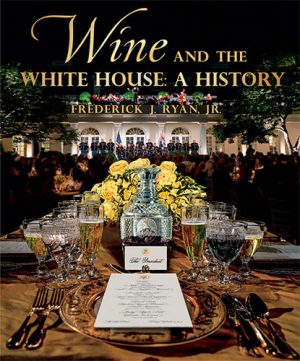Wine and the White House: A History, written by Frederick J Ryan Jr, publisher and CEO of The Washington Post, traces the role of wine at the US president’s table over the past 250 years.
Early presidents recognised the important function that wine played in entertaining at the White House, and State Dinners draw the world’s attention.
The first book of its kind, Wine and the White House takes readers on a journey through history to reveal just how influential wine has been to diplomatic relations at the White House.
It features illustrated menus, bills of sale, historic photographs, an index to all the wines served, plus photography of the White House collection of wine glasses, goblets, carafes, coolers and decanters.
Thomas Jefferson, the third president of the US and the second to live in the White House, was not only responsible for creating its first cellar but was the first president to establish many of the White House’s enduring traditions, including lavish dinner parties with multiple courses of food and wine.
Known by many as the “Founding Father of Wine,” Jefferson understood wine’s ability to oil social interaction by putting guests at ease and breaking down barriers. He also had a deep interest in and passion for wine, developed while serving as minister to France in the 1780s prior to becoming president.
While not all presidents had Jefferson’s knowledge and interest in wine, even the abstemious Rutherford B Hayes understood its influential role in diplomacy.
Under Ronald Reagan, wine service in the White House reached a level of interest unmatched since Jefferson’s era. Reagan also understood the value of wine in entertaining and diplomacy, especially during the 1980s when wine was rapidly growing in popularity in the US.
Author Ryan, who who is chairman of the Association’s board and served as a senior official in the Reagan administration, explains: “Wine has been connected to human celebration for more than 10,000 years and is symbolic of hospitality to cultures around the world. The rich history of wine service at the White House, where hospitality makes history, is a fitting subject for the White House Historical Association to explore.”

What people are saying about Wine and the White House
“A comprehensive story of the American presidents through the grapes and glasses they drank from.” – New York Times
“Fascinating . . . an in-depth look from an inside source at the sometimes colorful story of wine in the president’s residence.” – Wine Spectator
“A big book, beautifully produced, generously illustrated, and full of information.” – Wine Economist
“A superb book. It’s a joy to look at, but if you have even a prickle of curiosity about going behind the scenes to see how wine has entwined with American history and politics . . . you will be thrilled by this.” – Jancis Robinson MW
“Next time you drink a California Cabernet, make a toast to President Lyndon B Johnson: he helped popularise American wines by refusing to serve European bottles at state dinners. You’ll find this and other fun facts in Wine and the White House: A History.” – Food Network magazine







